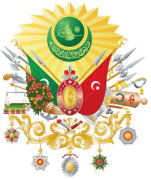 The typical military sign of the Ottoman Empire, known as "Arma" in Turkish, is formed by various (about 30) different elements all symbolizing something. This sign was used by the Ottoman infantry on the battalion banners. The sign was first used after Nizami-Jedid reforms, meaning "New Order" in Turkish, carried out by the sultan Selim III in the late eighteenth century.
The typical military sign of the Ottoman Empire, known as "Arma" in Turkish, is formed by various (about 30) different elements all symbolizing something. This sign was used by the Ottoman infantry on the battalion banners. The sign was first used after Nizami-Jedid reforms, meaning "New Order" in Turkish, carried out by the sultan Selim III in the late eighteenth century.
Another version tells that this sign was first used during the Crimean War (1853-1856) when Ottomans fought against Russians. It's said that Queen Victoria, trying to establish good relations during the War with the Ottoman sultan Abdulmecid, had this sign designed and offered to the sultan together with an "Order of the Garter" (Dizbagi Nisani in Turkish). The weapons and the balance on the sign were added later by the sultan Abdulhamit II during the second half of the 19th century and became the official military sign.
It is not the State Coat of Arms of the Ottoman Empire, as the Empire did not use any unlike the Europeans did. Here is the meaning of the Ottoman Military Sign:
- Red flag on the right is the Turkish flag.
- Green flag on the left is the Sacred Standard of the Caliphate.
- Eliptical figure in the middle and the turban above it symbolizes the Ottoman dynasty as the leader (or caliph) of all the Muslims in the World.
- Flowers on the left symbolize the Toleration of the Ottomans.
- Weight balance on the left symbolizes the Justice of the Ottomans.
- Books on the left under the balance are a Koran and a Law book, symbolizing the Islamic state.
- Weapons on the left and right symbolize the Ottoman Army.
- Sun symbolizes the greatness of the Ottoman state.
- Green medallion on the Sun with the sultan's seal (Tugra) within symbolizes the great Ottoman dynasty.
- Green half-moon below the sultan's seal (Tugra) symbolizes that the Ottoman state is the guard of the whole muslims around the World.
- The board where medallions are hanged symbolizes the roots of the Ottoman State and of the Turkish culture.
- Medallions hanging in the bottom symbolize various etnic nations within the State.

